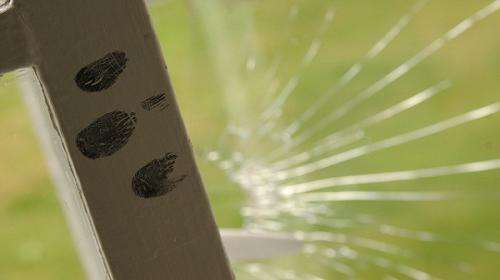The focus has been to get the clearest print possible from a range of surfaces including porous ones and extracting clear prints in wet or humid conditions. Credit: West Midlands Police
A NEW technique being developed by West Australian chemists could provide crime investigators with a safer, simpler and more versatile method for extracting good quality fingermarks, even from non-porous surfaces and in wet or humid conditions.
Curtin University's Simon Lewis says fingermarks on porous surfaces like paper can be extracted using treatments that target compounds like amino acids or lipids derived from skin secretions.
But detecting fingermarks on non-porous material and in wet or humid conditions is more complex and poses a number of challenges, particularly on dark and patterned material where results often lack sufficient contrast.
The compound Nile red is currently used, providing investigators with both contrast and photoluminescence. But Professor Lewis says it is expensive and the process uses the toxic solvent methanol which poses health and safety risks to personnel.
But his team of Curtin University researchers has found that when the compound Nile blue A (a basic phenoxazine dye) is made up in water, a small amount converts to Nile red in sufficient quantities (within the water solution) to develop the fingerprint.
"So you don't need the toxic solvent and what's more we don't seem to suffer from background luminescence," Prof Lewis says.
"So we've moved from a very expensive reagent in a toxic solvent to a very cheap one that can be made up in water.
"The added bonus is that as well as being able to use it on paper surfaces we can use it on non-porous surfaces like ceramic, glass and plastics and we found we can use it on the sticky side of adhesive tape.
"Sticky tape is very important in things like dangerous and suspicious packages and explosive devices."
The Curtin University team tested latent fingermarks on white copy paper from five donors who rubbed their scalp and faces to charge their marks with sebaceous lipids.
Prof Lewis says while a good deal more work needs to be done, testing shows great potential for the new process, particularly in staff training and for use in remote locations and developing countries.
He says fingermarks are crucial to criminal investigations because they link people to objects.
The aim of his team and several other groups around Australia has, over a number of years, been to get the clearest print possible from a range of surfaces including porous ones and extracting clear prints in wet or humid conditions.
More information: "Aqueous Nile blue: a simple, versatile and safe reagent for the detection of latent fingermarks." Amanda A. Frick, Francesco Busetti,a Andrew Cross, Simon W. Lewis. Chem. Commun., 2014, Advance Article. DOI: 10.1039/C3CC49577A
Provided by Science Network WA
























